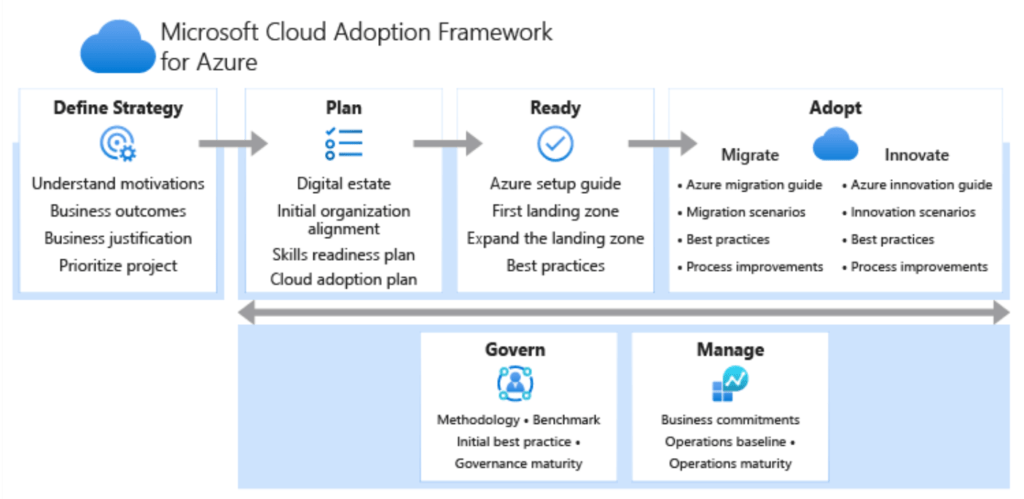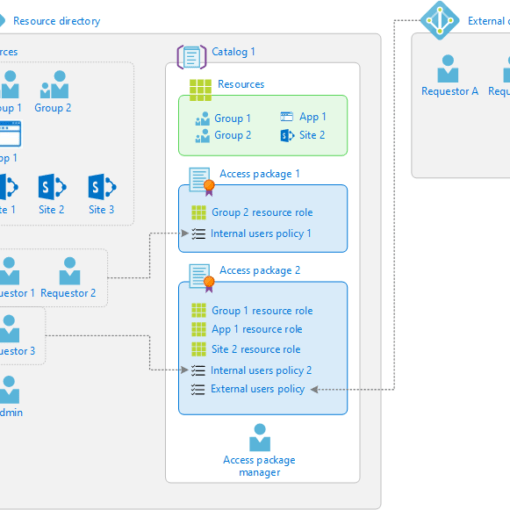
Embarking on a cloud journey can be an exhilarating yet challenging endeavour. Imagine setting sail on an expansive ocean without a map—daunting, right? The Azure Cloud Adoption Framework (CAF) serves as your meticulously crafted map, guiding you through the complexities of cloud adoption. In this blog post, we’ll dive into the Azure CAF, exploring its principles, phases, and best practices, and how it can steer your organisation towards a successful cloud transformation.
What is the Azure Cloud Adoption Framework?
The Azure Cloud Adoption Framework is a comprehensive collection of best practices, documentation, and tools designed to help organisations create and implement successful cloud strategies. It provides a structured approach to cloud adoption, ensuring that every aspect of the transition is planned, executed, and managed effectively.
The Azure CAF is organised into six key phases:
- Define Strategy: Establish your business objectives and motivations for adopting the cloud.
- Plan: Develop a detailed cloud adoption plan that aligns with your business goals.
- Ready: Prepare your environment and team for the move to the cloud.
- Adopt: Migrate existing workloads or build new cloud-native solutions.
- Govern: Implement governance practices to manage risks and ensure compliance.
- Manage: Continuously monitor and optimise your cloud environment.
- Secure: Protect your Cloud from Threats
- Organise: Organise to promote efficiency, governance, and operational excellence
Let’s take a closer look at each of these phases and how they contribute to a successful cloud journey.
Define Strategy: Setting Your Course
Before setting sail, it’s crucial to chart your course. The “Define Strategy” phase focuses on understanding your organisation’s motivations for adopting the cloud and defining clear business objectives. This involves identifying key drivers such as cost savings, agility, scalability, and innovation.
Key steps in this phase include:
- Business Alignment: Ensure that your cloud strategy aligns with overall business goals.
- Stakeholder Engagement: Involve key stakeholders to gain support and ensure alignment.
- Business Justification: Develop a compelling business case for cloud adoption.
Plan: Mapping Your Journey
With your destination in mind, it’s time to map out the journey. The “Plan” phase involves creating a detailed roadmap for cloud adoption and identifying the resources, skills, and timeline required to achieve your objectives.
Key steps in this phase include:
- Skills Assessment: Evaluate your team’s current skills and identify any gaps.
- Resource Planning: Determine the resources needed for cloud adoption, including tools and personnel.
- Timeline Development: Establish a realistic timeline for the adoption process.
Ready: Preparing for the Voyage
Before setting sail, you need to ensure your ship is seaworthy. The “Ready” phase focuses on preparing your environment and team for the transition to the cloud. This involves establishing a strong foundation, including governance, security, and operational practices.
Key steps in this phase include:
- Environment Preparation: Set up the necessary infrastructure and tools to support cloud adoption.
- Governance and Security: Implement governance and security measures to protect your environment.
- Team Readiness: Train your team on cloud technologies and best practices.
Adopt: Setting Sail
With everything in place, it’s time to set sail. The “Adopt” phase involves migrating existing workloads to the cloud or developing new cloud-native solutions. This phase is often divided into two sub-phases: “Migrate” and “Innovate.”
Key steps in this phase include:
- Workload Assessment: Evaluate existing workloads to determine the best migration strategy.
- Migration Planning: Develop a detailed plan for migrating workloads to the cloud.
- Innovation: Build new cloud-native applications to leverage the full potential of the cloud.
Govern: Navigating the Waters
As you navigate the cloud, it’s essential to maintain control and manage risks. The “Govern” phase focuses on establishing governance practices to ensure compliance, manage risks, and maintain security.
Key steps in this phase include:
- Policy Development: Create policies to govern the use of cloud resources.
- Risk Management: Identify and mitigate risks associated with cloud adoption.
- Compliance Monitoring: Ensure that your cloud environment complies with industry regulations and standards.
Manage: Sustaining the Journey
The journey doesn’t end once you’ve reached the cloud; it’s an ongoing voyage. The “Manage” phase involves continuously monitoring and optimising your cloud environment to ensure it remains efficient, secure, and cost-effective.
Key steps in this phase include:
- Performance Monitoring: Continuously monitor the performance of your cloud resources.
- Cost Management: Track and manage cloud spending to optimise costs.
- Operational Excellence: Implement best practices for maintaining and improving your cloud environment.
Secure: Safeguarding Your Ship
- Identity and Access Management (IAM): Use strong IAM policies, multi-factor authentication (MFA), role-based access control (RBAC), and Azure Active Directory (AAD).
- Data Protection: Encrypt data at rest and in transit, use Azure Key Vault, and implement data loss prevention (DLP) policies.
- Threat Protection: Detect and respond to threats with Azure Security Center and Azure Sentinel.
- Compliance and Governance: Ensure regulatory compliance using Azure Policy and regularly audit with Azure Compliance Manager.
Organize: Structuring Your Resources
- Resource Grouping: Organize resources into groups based on lifecycle, function, or department.
- Tagging Strategy: Implement a consistent tagging strategy to categorize resources.
- Subscription Management: Use multiple Azure subscriptions to separate environments like development, testing, and production.
- Management Groups: Organize subscriptions into hierarchies for unified management and governance.
Your Cloud Journey Awaits
The Azure Cloud Adoption Framework provides a comprehensive and structured approach to cloud adoption, ensuring that every aspect of the transition is planned, executed, and managed effectively. By following the phases of the Azure CAF, your organisation can confidently navigate the complexities of cloud adoption, achieving your business and technical goals.
So, hoist your sails, set your course, and let the Azure Cloud Adoption Framework be your trusted map on this exciting expedition. With the right strategy, planning, and execution, your cloud journey is bound to be a successful one. Happy cloud sailing!




